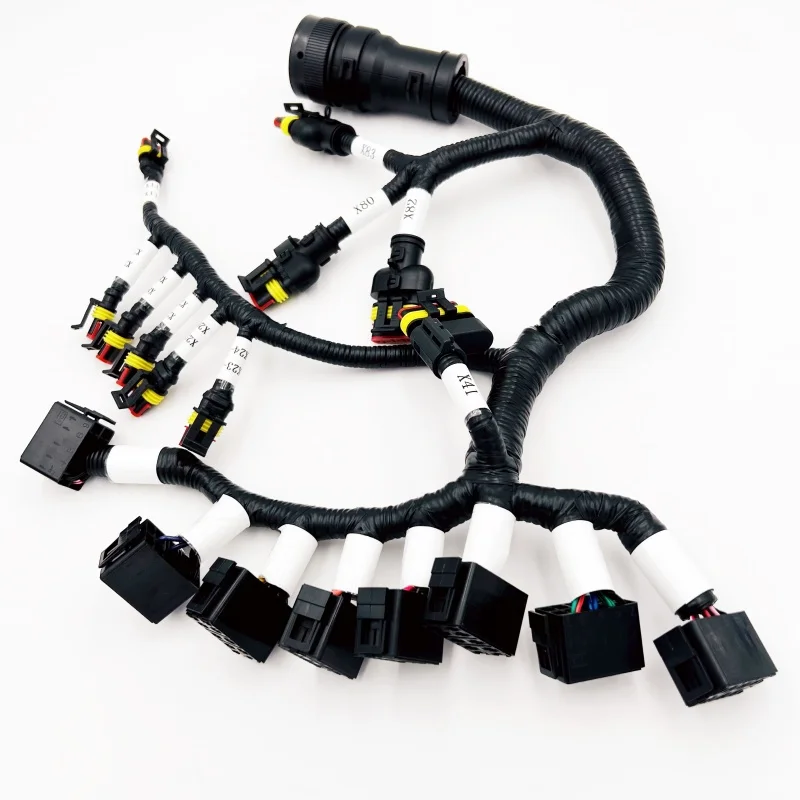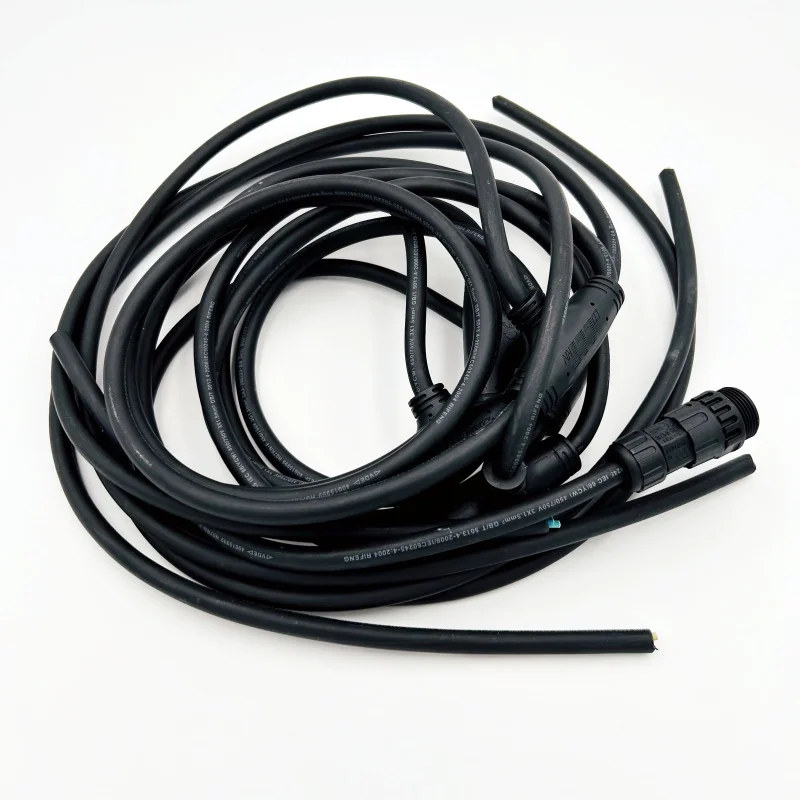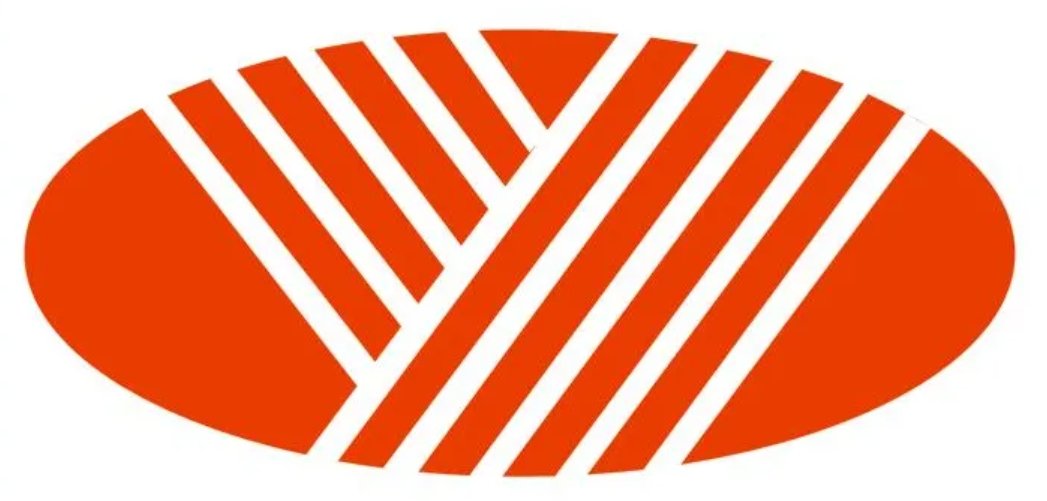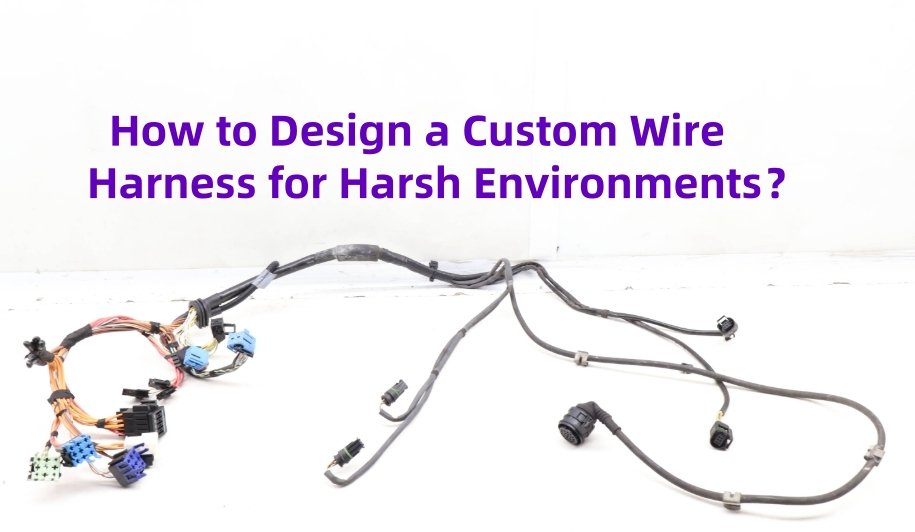Designing a wire harness for regular applications is fairly straightforward. But when your product must survive extreme heat, constant moisture, high vibration, intense UV exposure, or chemical contact, the entire approach needs to change. These harsh environments expose weaknesses quickly and can lead to serious performance failures if the harness is not properly designed.
I have seen how critical a well-built harness becomes in challenging settings. It is not just about making connections,it is about protecting your system, maintaining safety, and ensuring long-term reliability under pressure.
This blog is for engineers, product designers, and purchasing teams who need to design wire harnesses that perform under the most demanding conditions. Whether you are building industrial machinery, medical devices, automotive systems, or renewable energy products, this post will help you make smart, informed decisions that lead to success.
1.Understand the Application Requirements
Before I begin designing any custom wire harness, I always start by clearly understanding the application it will serve. This step is essential because the environment and operating conditions directly influence material selection, construction method, and long-term reliability.
First, I define the operational environment. Is the harness intended for indoor use in a controlled setting, or will it be exposed to outdoor conditions? Will it be used in a static installation, or does it need to withstand movement, vibration, or transport? For example, harnesses used in marine equipment, automotive systems, or industrial machinery all face very different environmental challenges, from saltwater exposure to constant mechanical stress.
Next, I look at the electrical requirements. I need to know the expected voltage and current levels, whether the harness will carry power or data signals, and if signal integrity is critical. Sensitive signals may require shielding, while high-power applications may demand thicker conductors or special insulation.
Finally, I identify any mechanical or environmental stress factors. Will the harness be exposed to heat or freezing temperatures? Is there risk of corrosion, oil exposure, or physical impact? Each of these factors must be considered during material selection and design planning to ensure the final harness can perform reliably over time.
By understanding these core requirements upfront, I can make better decisions throughout the design and production process and deliver a solution that fits the environment perfectly.
2.Select the Right Materials
Selecting the right materials is fundamental when designing a custom wire harness for harsh environments. The material choices you make will directly impact the harness’s ability to withstand extreme conditions such as high or low temperatures, moisture, chemicals, UV exposure, mechanical stress, and more. Here’s how to approach material selection for maximum durability and reliability.
a.Conductor Materials
Copper is the industry standard due to its excellent conductivity and flexibility, but in harsh settings, enhancements like tinned, silver-plated, or nickel-plated copper are preferable for increased corrosion resistance and enduring high temperatures. For weight-sensitive applications, aluminum can be considered but is less common due to lower conductivity and mechanical strength. Stranded wire is used where flexibility is needed in high-vibration or dynamic environments; solid core is reserved for static installations.
b.Insulation and Sheathing
Insulation is critical for electrical safety and environmental protection. Top choices for extreme conditions include:
- PTFE (Teflon): Outstanding resistance to heat, chemicals, oil, and water. Ideal for aerospace or industrial use where performance must be maintained even at temperatures above 200°C.
- Polyimide (PI): Handles temperatures up to 400°C, making it suitable for aerospace or engine compartments.
- Cross-linked Polyethylene (XLPE): Excels in moisture and corrosion resistance, good for marine and high-humidity applications.
- Fluorinated polymers (FEP, ETFE, PVDF): Deliver chemical, UV, and flame resistance, with flexibility over wide temperature ranges.
- Silicone: Highly flexible, excellent for environments with rapid temperature cycling or mechanical movement, and remains stable up to 180°C.
- Fiberglass: Used for the highest temperature and most severe duty cycles, withstanding up to 480°C in specialized uses.
- Standard PVC and polyurethane may suffice for less demanding situations but, for truly harsh conditions, advanced materials are typically required.
c.Outer Protection and Shielding
For extra protection, consider:
- Braided or foil shielding: To reduce EMI and RFI interference.
- Protective sleeving, over-molding, or heat-shrink tubing: To guard against abrasion, moisture intrusion, and chemical attack.
- Waterproof and dustproof connectors: Ensure system integrity in wet or contaminated spaces.
d.Traceability and Certification
Use materials that are traceable and certified to meet required environmental and electrical standards. Trusted brands and international certifications (UL, RoHS, IPC/WHMA-A-620) guarantee consistent quality and compliance with regulations.
3.Protection and Sealing Methods
In harsh environments, simply using durable materials isn’t enough,your wire harness must also be protected and sealed to prevent failures caused by water, dust, vibration, or electromagnetic interference. Proper sealing methods enhance the reliability and longevity of your design.
8 Keys protection and sealing methods as follow:
a.Heat Shrink Tubing
This material provides mechanical protection as well as an effective moisture barrier by tightly sealing wire bundles and connectors. Heat shrink tubing conforms to irregular shapes, protecting against abrasion, dust, and water ingress.
b.Overmolding
Encapsulating connectors and junctions with thermoplastic elastomers (TPE), silicone, or similar materials creates a robust protective barrier that offers strain relief and environmental sealing against moisture, chemicals, and mechanical stress. Overmolding is ideal for complex assemblies requiring reinforced connections.
c.Sealed Connectors
Use connectors with built-in sealing rings or gasket materials rated for water and dust resistance (e.g., IP67 or MIL-DTL-38999 military-spec connectors). These prevent contaminants from entering contact points and causing corrosion or shorts, critical in wet or dirty environments.
d.Protective Sleeving and Braiding
Applying braided or spiral-wrapped sleeving made of materials such as PET, nylon, or stainless steel shields wires from mechanical wear, abrasion, and vibration. Sleeving also helps protect against UV exposure and chemical attack.
e.Conduits and Protective Tubing
Rigid or flexible conduits provide additional mechanical protection from crushing, cutting, and impact damage. Metal conduits are common in extreme mechanical environments, while non-metallic conduits offer chemical resistance and flexibility.
f.Sealing Techniques at Routing Points
Using grommets, clamps with vibration damping, and sealed bulkhead feed-throughs help prevent harness movement, reduce mechanical fatigue, and maintain environmental seals where wires enter enclosures or panels.
g.Corrosion-Resistant Platings and Materials
Connectors and terminals use nickel or gold plating to resist corrosion, especially in marine or chemically aggressive environments.
h.EMI/RFI Shielding If Needed
In environments with high electromagnetic activity such as medical devices, military equipment, or industrial control systems EMI (Electromagnetic Interference) or RFI (Radio Frequency Interference) can disrupt signal integrity.
To prevent this, use shielded cables, foil wraps, or braided shielding, and ensure proper grounding throughout the harness. These measures are especially important for communication lines, sensor cables, and data transfer circuits.
These protection and sealing methods collectively enable the harness to withstand extreme temperatures, moisture, vibration, chemical exposure, and UV radiation, ensuring safe and durable operation in harsh settings. Incorporating these features early in the design and working closely with manufacturers experienced in ruggedized wiring harnesses is vital for success.

4.Mechanical Design Considerations
In harsh environments, mechanical integrity is just as important as electrical performance. A well-thought-out mechanical design helps ensure your custom wire harness remains secure, durable, and easy to maintain,reducing failure risks caused by physical stress. Here’s what to focus on:
a.Routing and Bend Radius Planning
Proper wire routing prevents pinching, crushing, and unnecessary tension. Avoid sharp bends or tight corners by respecting the minimum bend radius typically 10 times the cable diameter for standard cables. Plan cable paths to minimize friction, interference with moving parts, and exposure to heat or vibration sources. Use 3D CAD design or mock-ups to simulate harness routing inside your equipment.
b.Strain Relief to Prevent Breakage or Wear
Strain relief is essential in high-vibration or flexing environments. Without it, wires can break at connection points or terminals due to constant pulling or bending. Use strain relief boots, clamps, or overmolding to distribute mechanical stress and protect wire terminations from fatigue. This is especially important at connector interfaces and entry/exit points of enclosures.
c.Cable Bundling and Securing Methods
A clean, organized harness is less likely to suffer damage during operation. Use appropriate bundling techniques such as:
- Tie wraps (with proper tension to avoid over-tightening)
- Mounting clips or clamps to fix harnesses in place
- Protective sleeves (braided, woven, or spiral wrap) for added abrasion resistance
- These methods reduce wear from movement, prevent accidental snagging, and keep cables protected from environmental hazards.
d.Connector Placement and Accessibility for Maintenance
Design for easy access to connectors and service points. Place connectors where they’re easy to reach during assembly or repair, without needing to disassemble the entire system. Also, consider labeling wires and using color coding to simplify troubleshooting. This is particularly valuable in field service situations, where downtime must be minimized.
5.Manufacturing Process Considerations
When considering manufacturing process considerations for custom wire harnesses destined for harsh environments, seven critical factors must be incorporated to ensure durability, reliability, and safety under extreme conditions:
a.Material Selection and Handling
Manufacturing must use high-quality, environment-resistant materials such as heat-resistant insulation (e.g., PTFE, silicone, polyimide), corrosion-resistant conductors (tinned copper or special alloys), and protective jackets resistant to moisture, chemicals, abrasion, and UV. Proper material traceability and storage to avoid contamination or damage during production is essential.
b.Precision and Automation in Assembly
Utilizing automated processes such as precision crimping machines and injection molding ensures consistent, high-quality connections with minimal human error. Automation enhances repeatability, critical in producing harnesses capable of withstanding vibration and mechanical stress.
c.Full In-House Process Control
Controlling all steps in-house from wire cutting and stripping, crimping, overmolding, to comprehensive electrical testing improves quality control, reduces lead times, and allows rapid response to design changes. This vertical integration is crucial for managing complex harnesses tailored to harsh environments.
d.Protective Processes
Incorporate specialized protection techniques such as heat-shrink tubing, overmolding of connectors and junctions, and sealed connectors with appropriate IP ratings to prevent ingress of moisture, dust, and chemicals. These steps protect against environmental threats like corrosion and electrical shorts.
e.Environmental and Mechanical Testing
Rigorous testing protocols including thermal cycling, salt spray, vibration, flexing, hipot (high voltage) tests, and electrical continuity checks validate the harness’s performance in real-world harsh conditions. Continuous in-process inspections and post-assembly testing are essential to detect defects early.
f.Workflow Optimization and Quality Assurance
Manufacturing facilities equipped with clean, organized workflows, trained personnel, and real-time process monitoring enable consistent quality output. Advanced quality management systems maintaining full batch traceability help meet certifications such as ISO 9001 and IPC/WHMA-A-620.
g.Customization and Flexibility
Manufacturing processes must be adaptable to custom specifications including special wire types, complex routing, custom connectors, and various production volumes from prototype to mass production, ensuring responsiveness to client needs.
In essence, the manufacturing process for wire harnesses designed for harsh environments demands meticulous material handling, automated precision assembly, comprehensive protection methods, thorough testing, and stringent quality control ideally managed in a vertically integrated facility that ensures flexibility, traceability, and reliability throughout production.

6.Testing and Validation
For harsh environments there are several essential methods designed to ensure durability, reliability, and safety. Testing generally focuses on three critical areas: mechanical integrity, electrical performance, and environmental resistance.
a.Mechanical Testing
This assesses the physical robustness of the wire harness. Typical tests include tensile strength, bending, twisting, abrasion resistance, vibration resistance, and connector durability. The goal is to confirm the harness can withstand the mechanical stresses it will encounter during installation and operation without damage or failure.
b.Electrical Testing
Electrical tests verify the harness’s functionality and safety. These include:
- Continuity testing: Confirms uninterrupted electrical paths and correct wiring.
- Insulation resistance testing: Measures the quality of the insulating material to prevent leakage or short circuits.
- High voltage or dielectric strength testing: Verifies the harness can handle voltages above normal operating conditions without breakdown.
- Current and voltage load testing: Ensures the harness components tolerate the expected electrical loads without overheating or failure.
c.Environmental Testing
Given harsh environment requirements, these tests simulate real-world conditions to evaluate the harness’s reliability:
- Thermal cycling: Subjecting the harness to repeated rapid heating and cooling to check for material or connection integrity degradation.
- Salt spray testing: Examines corrosion resistance, crucial for marine or salty environments.
- Humidity testing: Tests moisture ingress and resistance to ensure insulation and connectors remain effective.
- Vibration testing: Simulates operational vibrations to detect potential loosening, wear, or failure.
- Chemical exposure and UV resistance: Assess durability against corrosive substances and sunlight degradation, respectively.
Other tests may include insertion and extraction cycles to evaluate connector durability, static and dynamic thermal aging tests for long-term high-temperature exposure, and comprehensive reliability tests simulating entire service life conditions.
7.Work with an Experienced Manufacturer
Designing a custom wire harness for harsh environments involves more than just technical expertise. It requires the support of a capable manufacturing partner who understands your challenges and can provide practical solutions. Working with an experienced company like Yihetai from the beginning brings valuable advantages that can impact the success of your entire project.
a.Importance of Early Collaboration with a Manufacturer Like Yihetai
Involving your manufacturer early allows for better alignment between your design goals and production capabilities. At Yihetai, our engineering team works closely with customers from the concept stage, helping with wire specifications, connector choices, layout design, and protection strategies. This early collaboration minimizes errors, speeds up development, and helps avoid costly revisions later in the process.
b.Benefits of In-House Design, Prototyping, and Testing
Yihetai offers complete in-house services for design, prototyping, and product validation. With access to advanced tools and experienced technicians, we can quickly turn your design into a working prototype. Our dedicated testing facilities ensure each sample meets electrical, mechanical, and environmental requirements before moving into production. This hands-on approach shortens lead times and ensures reliable results.
c.Ensuring Scalability from Small Orders to Mass Production
Whether you are starting with a limited pilot run or planning large-scale distribution, Yihetai has the flexibility to meet your needs. Our facility supports both small-batch and high-volume production with consistent quality. Using a combination of manual precision and automated processes, we maintain efficiency and accuracy at every stage. This scalability gives you the confidence to grow your product line without changing suppliers.
Partnering with an experienced manufacturer ensures that your wire harnesses are built to last and ready for real-world conditions. At Yihetai, we provide more than just products also deliver solutions tailored to your application and built for long-term success.
8.Common Mistakes to Avoid
Designing a wire harness for harsh environments requires more than basic engineering knowledge. Even small oversights can lead to premature failure, costly downtime, and safety risks. Here are nine of the most common mistakes to watch out and how to avoid them.
a.Inadequate Planning and Understanding of Environment
Failing to fully assess the harsh conditions such as extreme temperatures, moisture, vibration, chemicals, and UV exposure can lead to choosing inappropriate materials or designs that will prematurely fail.
b.Poor Wire Routing and Harness Layout
Incorrect routing can cause wires to overheat, experience mechanical stress, or suffer from signal interference. Avoid placing wires near heat sources or sharp edges, and ensure enough spacing to prevent abrasion and cross-talk.
c.Ignoring Material Compatibility
Using standard or low-grade insulation and conductor materials not rated for the environment leads to premature cracking, corrosion, or loss of flexibility. Selecting heat-resistant, corrosion-resistant, and UV-stable materials is essential.
d.Excessive Connectors and Failure Points
Each connector or junction is a potential failure spot, especially in harsh conditions where corrosion or mechanical stress occurs. Minimizing connectors and using sealed, corrosion-resistant types enhances durability.
e.Improper Lengths and Wire Sizes
Incorrectly sized wires or wrong length harnesses cause installation problems and electrical losses. A harness too short can create tension, while overly long wires cause clutter and potential signal issues.
f.Neglecting EMI/RFI Shielding
In environments with electromagnetic interference, omitting proper shielding or grounding can cause signal degradation and system malfunction.
g.Lack of Rigorous Testing and Validation
Skipping thorough electrical, mechanical, and environmental testing increases risk of field failure. Tests like thermal cycling, salt spray, vibration, insulation resistance, and hipot are crucial to proving design robustness.
h.Overlooking Traceability and Certification
Not ensuring materials and processes comply with relevant certifications (UL, IPC/WHMA-A-620, ISO) may affect reliability and complicate quality control and regulatory compliance.
i.Poor Communication with Manufacturers
Lack of clear specifications and collaboration with experienced manufacturers can lead to design errors, quality issues, or delays.
Avoiding these mistakes by comprehensive planning, rigorous material selection, precise design, minimizing failure points, and robust testing ensures your wire harness will withstand harsh environments reliably. Working closely with knowledgeable manufacturers further enhances success in rugged applications.
FAQ:
Q1:What are the most common wire jacket materials used in harsh conditions?
A:The most common wire jacket (insulation and outer sheathing) materials used in harsh environments are chosen for their resistance to extreme temperatures, moisture, chemicals, abrasion, UV exposure, and mechanical stress. Key materials include:
PTFE (Polytetrafluoroethylene, also known as Teflon)
- Exceptional resistance to high temperatures (up to around 260°C or more)
- Excellent chemical resistance against oils, solvents, and corrosive substances
- Durable in wet and high-moisture environments
- Common in aerospace and industrial applications requiring chemical and heat resistance.
Polyimide (PI)
- Can withstand very high temperatures (up to 400°C)
- Used in extreme heat aerospace applications and engine compartments
- Maintains electrical and mechanical properties under intense thermal stress.
Cross-Linked Polyethylene (XLPE)
- Offers superior moisture and corrosion resistance
- Suitable for marine or high-humidity environments
- Good mechanical and chemical durability.
Fluorinated Polymers (such as ETFE, FEP, PVDF)
- Resistant to UV, chemicals, and flame
- Provides flexibility and durability in harsh chemical and outdoor conditions
- Used where both chemical and environmental stability are required.
Silicone
- Flexible and withstands rapid temperature cycling (up to around 180°C)
- Good mechanical flexibility, vibration resistance
- Suitable for dynamic or moving parts exposed to temperature extremes.
PVC (Polyvinyl Chloride) and Polyurethane (PU)
- Common in less extreme environments but with options formulated for extra durability
- Good abrasion resistance, flexibility, and chemical resistance in certain grades
- Used where budget constraints exist or moderate environmental protection is sufficient.
- Protective Outer Layers and Shielding
- Braided sleeving (PET, nylon, stainless steel) offers mechanical abrasion and UV protection
- Heat-shrink tubing and overmolding with thermoplastic elastomers provide moisture sealing and strain relief
- Sealed connectors and corrosion-resistant plating (nickel, gold) enhance durability in marine and chemical environments.
These materials are selected based on the specific environmental stressors expected (temperature extremes, moisture, chemicals, vibration) and combined with mechanical design and protective techniques for reliable long-term performance in harsh conditions.
Q2:How do you choose between standard and custom components/connectors for harsh environments?
A:When I design a wire harness for a harsh environment, one of the key decisions I make is whether to use standard components or develop custom ones. This choice depends on several factors including environmental conditions, design limitations, performance requirements, and cost.
I always begin by evaluating the environment. If the harness will face water, dust, extreme temperatures, vibration, or exposure to chemicals, I check whether any high-quality standard connectors are suitable. Well-known brands like Molex, JST, AMP, and HRS offer components that meet demanding industrial and automotive standards.
I choose standard components when the operating conditions are within common industry limits. Standard connectors are also a good choice when I need faster delivery, easy replacement, or compatibility with other systems already in use. They are typically more cost effective for projects with moderate complexity and volume needs.
I choose custom components when the project involves space limitations, unusual configurations, or specific technical needs that standard parts cannot support. For example, if I need a connector to carry both signal and power in a compact space, or if the application requires specialized sealing or integration with a PCB or sensor, a custom design may be the best option.
Finally, I always weigh the total life cycle value. While standard parts may offer faster sourcing and lower initial costs, custom components can provide better long-term performance, reduce the risk of failure, and simplify installation.
At Yihetai, we support both standard and custom solutions, helping our clients choose the best approach based on the environment, budget, and performance goals.
Q3:How can overmolding improve durability in harsh conditions?
A:Overmolding is one of the most effective techniques I use to improve the durability and reliability of wire harnesses in harsh environments. It involves molding a protective layer of material—typically a thermoplastic or elastomer directly over connectors, junctions, or cable interfaces. Here is how overmolding enhances performance in tough conditions:
- Provides a Sealed Barrier Against Moisture and Contaminants: Overmolding creates a seamless, tight seal that protects sensitive internal components from water, dust, dirt, oil, and chemicals. This is especially important for outdoor, marine, or industrial applications where exposure to the elements is unavoidable.
- Adds Mechanical Strength and Strain Relief: It reinforces weak points in the assembly, particularly where wires enter connectors. This helps prevent cable breakage, connector damage, or wire pull-out due to bending, tugging, or vibration over time.
- Improves Thermal and Chemical Resistance:The molded material can be selected based on the environmental demands of the application. Whether the harness needs to withstand high heat, cold, or chemical exposure, the overmold can act as the first line of defense.
- Reduces Assembly Time and Enhances Appearance: Overmolding simplifies the final assembly by eliminating the need for separate boots, grommets, or sealants. It also gives the harness a clean, professional appearance with consistent dimensions and finish.
- Enhances Safety and Reliability:By locking in the cable termination and preventing ingress of moisture or corrosive agents, overmolding helps maintain electrical continuity and long-term performance critical in safety-sensitive environments such as automotive, aerospace, and medical devices.
In my experience, adding overmolding to a harsh environment harness is one of the best investments for extending service life and reducing maintenance or warranty issues. At Yihetai, we offer full in-house overmolding capabilities tailored to your specific project needs.
Q4:Why is EMI shielding important in harsh environments?
A: EMI shielding is critically important in harsh environments because it protects sensitive electronic components from electromagnetic interference that can cause signal degradation, data corruption, or complete system failures. Harsh conditionssuch as extreme temperatures, high vibration, moisture, and chemical exposure can exacerbate EMI problems by weakening materials or causing mechanical stress that makes devices more vulnerable to disruptions. Effective shielding creates a conductive barrier that blocks or absorbs external electromagnetic noise and prevents internal signals from leaking, thereby maintaining signal integrity and reliable operation in demanding settings.
In applications like aerospace, automotive, industrial machinery, and defense, where safety and precision are crucial, EMI shielding ensures communication, control, and navigation systems function without critical errors or downtime. It also helps products meet industry standards and regulatory compliance related to electromagnetic compatibility. Additionally, shielding enhances overall system durability by protecting components against environmental factors that would otherwise accelerate wear and failure.
Q5:Can custom wire harnesses be designed for UV and chemical resistance?
A:Yes, absolutely. I often design custom wire harnesses specifically for UV and chemical resistance, especially for use in outdoor, industrial, or chemically aggressive environments. These harnesses must be built with the right materials and construction techniques to maintain long-term reliability and safety.
Here is how I ensure UV and chemical resistance in a custom harness:
- a.Select UV-Stable Jacket Materials
- For outdoor or sun-exposed applications, I choose jacket materials like polyurethane (PUR), cross-linked polyethylene (XLPE), TPE, or PTFE. These materials resist ultraviolet light without cracking, fading, or degrading over time.
- Use Chemical-Resistant Insulation and Jackets
- In environments with oils, fuels, solvents, or cleaning agents, I use materials such as PTFE, FEP, or fluoropolymer blends. These resist chemical corrosion and prevent the cable from softening or swelling.
- Apply Protective Coatings or Overmolding
- In some cases, I add overmolding or apply chemical-resistant coatings to exposed connectors or junctions to create a sealed, reinforced barrier.
- Test Under Real Conditions
- At Yihetai, we can perform chemical exposure tests, UV aging tests, and salt spray tests during the development process to ensure the harness meets your durability requirements.
Whether you are building equipment for agriculture, chemical plants, solar energy, or marine applications, I can design a custom solution that stands up to harsh UV and chemical exposure. Let me know your environment, and I will match the right materials and protection methods to your needs.
Q6:Is it better to use silicone, PTFE, or TPE for insulation in extreme environments?
A: When choosing between silicone, PTFE (Teflon), and TPE for insulation in extreme environments, each material has distinct advantages and limitations depending on the specific conditions:
| Property / Material | Silicone | PTFE (Teflon) | TPE (Thermoplastic Elastomer) |
| Temperature Range | -60℃ to +200℃ (continuous) | -66℃ to +200℃ (continuous) | Typically -40℃ to around+125℃ |
| Flexibility | Highly flexible,remains elastic even at very low | Less flexible, tends to harden and get brittle at low temps | Flexible but less resistant atvery high temps |
| Chemical Resistance | Excellent resistance to chemicals, heat, UV | Exceptional chemical and heat resistance suitable for very | Good chemical resistance butless than PTFE |
| Abrasion Resistance | Moderate abrasion resistance | Generally lower abrasion resistance, brittle if stressed | Good abrasion resistance |
| Installation Ease | Easy to handle, very elastic, good for confined spaces | More rigid, can be harder to install in tight areas | Similar flexibility to silicone,easier to form and recycle |
| Flame Resistance | Flame retardant, low smoke, no toxic halogens on burning | Very high flame resistance, self- extinguishing | Flame retardancy varies,generally lower than silicone and PTFE |
| Cost | Moderate to high | High, more expensive | Generally more cost-effective |
| Typical Applications | Food, medical, aerospace, automotive cables | Aerospace, military | General industrial, automotive consumer cables where moderate heat and flexibility |
Summary:
PTFE is the best choice if the application demands the highest temperature tolerance (up to 260°C), outstanding chemical resistance, and very robust electrical insulation. It is less flexible and more expensive, and installations can be more challenging due to rigidity and low resilience to mechanical abrasion.
Silicone offers excellent flexibility, especially in very cold conditions, with good heat resistance (up to 200°C), chemical resistance, and flame retardancy. It installs easier in confined or dynamic environments and is a strong choice when flexibility and moderate to high temperature resistance are both important.
TPE is generally used when good flexibility and cost are critical but the environment is less extreme regarding temperature and chemical exposure. It lacks the high temperature performance and extreme chemical resistance of PTFE and silicone but offers easy processing and recyclability.
In conclusion, for extreme environments especially involving very high temperatures and aggressive chemicals, PTFE insulation is generally superior. If your application requires flexibility and good performance over a wide temperature range including very low temperatures, silicone is often preferable. TPE may be chosen for less demanding harsh environments where budget and flexibility are prioritized.
Conclusion
Designing a custom wire harness for harsh environments requires attention to every detail. I have learned that precision in both design and material selection is not optional,it is essential. The right choices ensure performance, safety, and reliability, even in the most demanding conditions.
That is why I always encourage working with experienced and certified manufacturers. A trusted partner understands the unique challenges of harsh environments and brings both technical expertise and quality control to the table. This level of support can make the difference between a product that lasts and one that fails.
If you are developing a project that will face tough environmental stress, I invite you to reach out to Yihetai. With over two decades of experience and full in-house capabilities, we provide tailored wire harness solutions designed to perform where others fall short. Let’s build something dependable together.


